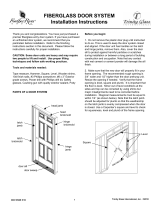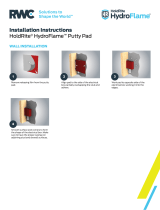
Please follow our standard set of installation instructions when installing this door unit. Below are some additional tips as it relates to
installing this type of jamb system. This jamb material can be nailed or screwed to install the unit but it is highly recommended to pre-drill
this material prior to applying any fastener, especially on the pre-colored material due to the finish (may cause cracking or flaking).
1) Jamb Installation: Please follow the set of Feather River Installation Instructions included with the door unit purchased. You can
fasten the jambs by pre-drilling holes and securing with a #8- 3" exterior grade screw. See drawings below.
a. Included in this installation packet will be 10-Phillip head screw caps that complement the color of the PVC jamb system.
These tap caps press on top of a Phillips head counter sunk screw. For a pre-colored jamb (with a stain color): Also
included is a putty stick that complements the pre-colored jamb, this can also be utilized to fill any fastening points.
b. For larger jamb sizes (6-9/16" to 8-9/16") it is sometimes recommended to fasten the jamb in two locations along the
width of the jamb.
2) Brickmold Application:
a. PVC Brickmold can be applied in a similar fashion to wood. It is always recommended to use an exterior
grade finish nail and pre-drill any fastening location, especially on the pre-colored material.
b. To keep 45˚ top angle closed/tight it may be necessary to pre-drill and apply a screw or nail through top of brickmold.
c. Once installation is complete remember to caulk around the brickmold.
d. Pre-Colored Brickmold (with a stain color): Putty stick can be used to fill any fastening points.
3) Interior Trim Installation:
a. Make sure any fastening point into the pre-colored/hand stained PVC jamb system is pre-drilled prior to nailing
with a finish nail. Nail holes would be covered up using caulk or wood putty depending on type of trim being applied.
4) Storm/Security Door Application: IMPORTANT
a. Non-Vented Storm Doors will void the warranty on any Feather River Door due to the extreme heat build-up if not
properly vented.
b. If applying a storm door over this unit it is recommended that any fastening point be pre-drilled.
c. Feather River will not be responsible for any damage that may occur with the installation of a Storm/Security door setup.
Para la instalación de esta unidad, siga las instrucciones habituales. Debajo, encontrará información adicional acerca de la instalación de este tipo de sistema de marco.
Durante la instalación, pueden utilizarse clavos o tornillos directamente sobre el material del marco. Sin embargo, es recomendable taladrar o hacer los orificios con anterioridad
para proteger el acabado, en especial si el marco es de color, de lo contrario, el acabado se puede agrietar o descascarar.
1) Instalación del marco: siga las instrucciones de instalación de Feather River que vienen con la abertura. Para atornillar el marco, haga primero los agujeros con un taladro y
luego coloque un tornillo para exteriores número 8 de 3 pulgadas. Vea las ilustraciones que aparecen a continuación.
a. El paquete para la instalación incluye 10 tapas para tornillos con cabeza Phillips que se adecuan al color del marco. La tapa se coloca a presión sobre el tornillo avellanado
Phillips. Para una jamba pre-coloreado (con un color de la mancha): También se incluye un palo masilla que complementa el color de la jamba, esto puede también ser
utilizada para llenar los puntos de fijación.
b. Para marcos más grandes (6-9/16" a 8-9/16") es recomendable colocar dos tornillos a lo largo del ancho.
2) Aplicación de la moldura:
a. La moldura de PVC se coloca de manera similar a una moldura de madera. Es recomendable utilizar clavos de acabado para exteriores y
taladrar los orificios para los tornillos de antemano, especialmente en las molduras de color.
b. Para mantener el ángulo superior fijo a 45˚, es posible que necesite colocar un tornillo o un clavo a través de la parte superior de la moldura.
c. Una vez terminada la colocación, recuerde aplicar masilla alrededor de la moldura.
d. Moldura pre-coloreado (con un color de la mancha): La palo de la masilla se puede utilizar para llenar cualquier puntos de fijación.
3) Colocación del contramarco:
a. Al colocar un marco de color o pintado con tinte, asegúrese de hacer todos los orificios antes de clavar los clavos de acabado.
Los orificios de los clavos se pueden cubrir con masilla o con masilla para madera según el tipo de contramarco que haya colocado.
4) Colocación de la puerta de seguridad/contrapuerta: IMPORTANTE
a. Las puertas de seguridad sin entrada de aire invalidan la garantía de cualquier puerta Feather River debido a la cantidad excesiva
de calor que se acumula cuando no se ventilan adecuadamente.
b. Al colocar una puerta de seguridad, es recomendable que todos los orificios para los tornillos se hagan con anterioridad.
c. Feather River no se responsabiliza por los daños que puede causar la colocación de una puerta de seguridad o contrapuerta.
6/15 © 2015 Trinity Glass International, Inc.
Instalación - AnexoMarco de material PVC –
Blancas sin acabado • Pre-coloreado
PVC JAMB SYSTEMS
White Unnished • Pre-Colored
INSTALLATION
ADDENDUM PAGE
WEATHERSTRIP
Burlete
WEATHERSTRIP
Burlete
JAMB
Marco de la puerta
SHIM
Cuña
SHIM
Cuña
BRICKMOLD
Moldura
WALL STUD
Marco de la pared
SINGLE DOOR w/SIDELITE(s)
Puerta con una o más ventanas laterales
SINGLE/DOUBLE DOOR
Puerta simple o doble
BRICKMOLD
APPLICATION
(Step B above)
Moldura colocación
(Ver paso B mencionado anteriormente)
SCREW TAP CAP
Tapa para tornillo
JAMB
Marco
SHIM
Cuña
SHIM
Cuña
BRICKMOLD
Moldura
WALL STUD
Marco de la pared
PRE-DRILLING DETAILS
Detalles De Perforación Previa
















